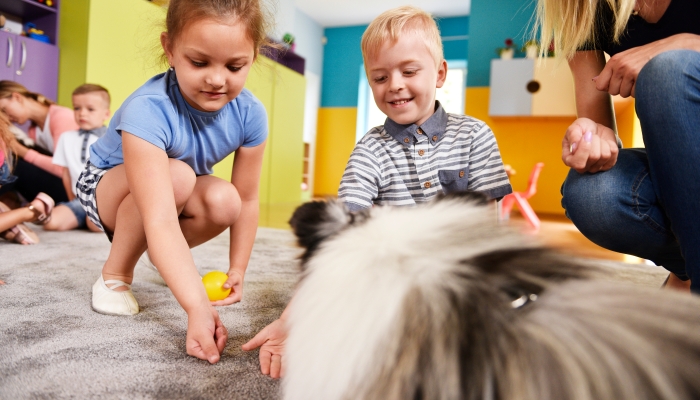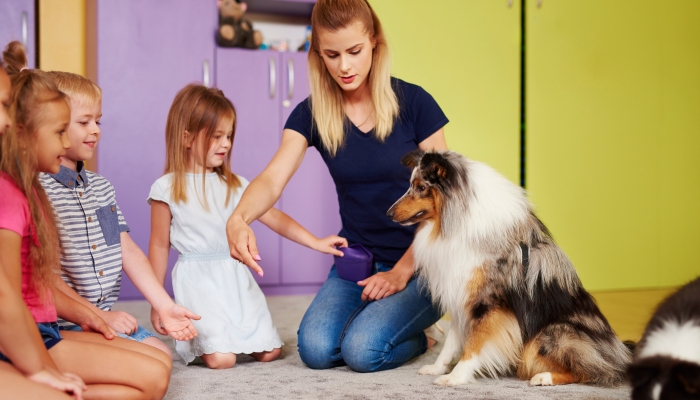Should Therapy Dogs Be Allowed in Schools?

- Therapy dogs can positively impact schools by encouraging cognitive development, reducing stress, and enhancing students’ well-being.
- Research shows that therapy animals can provide support, lead to reduced anxiety, and boost academic engagement in students.
- Therapy dogs should undergo additional training to ensure they are the right fit for a school program.
Therapy dog work is an impressive field, and I admire those in animal-assisted therapy programs. My own kids have participated in the Read with Dogs program at the local library, which boosts young kids’ confidence as they learn how to read. I didn’t realize such a program existed until we encountered it one day.
I was impressed with how the dogs lay down while my kids read their favorite Elephant and Piggie books. The dogs weren’t there to judge or point out any mispronunciations; they were there to help them enjoy reading without worrying about comments from the other side.
While further research is needed to determine the long-term effects of therapy dogs in schools, plenty of research shows the significant impact of these special dogs.
Understanding Therapy Dogs

There’s a unique human-animal bond between a person and their dog. Research shows that owning a dog11. Get healthy, get a dog: The health benefits of canine companionship. Harvard Health. https://www.health.harvard.edu/promotions/harvard-health-publications/get-healthy-get-a-dog-the-health-benefits-of-canine-companionship#:~:text=provide%20companionship,the%20lives%20of%20older%20individuals helps you be calmer, more present in life, and more mindful, regardless of whether you are an adult or a child.
We have a three-year-old dog; I call her our “unofficial therapy dog.” She has no special training, but when one of my kids is upset or sick, she walks over to them and lays down. I’ll see their tears drop on her fur as she licks their hands.
With the amount of studies behind it, there’s no question why bringing canine companions into a classroom is popular. A school counselor can better assess the individual needs of their school and make modifications as needed.
What are Therapy Dogs?
According to the American Kennel Club, therapy dogs aren’t service dogs22. What Is a Therapy Dog?. American Kennel Club. https://www.akc.org/sports/title-recognition-program/therapy-dog-program/what-is-a-therapy-dog and instead go with their owners to volunteer in different settings, including schools, nursing homes, and hospitals.
The impact a dog in the classroom can have on students is impressive. For example, a University of California study found that students participating in a canine reading program experienced an increase in their reading fluency from 12% to 30%33. UC Delivers. University of California, Agriculture and Natural Resources. https://ucanr.edu/delivers/?impact=800.
The definition of a therapy dog44. Kropp, J. J., & Shupp, M. M.. Review of the Research: Are Therapy Dogs in Classrooms Beneficial?. ERIC Institute of Education Sciences. https://files.eric.ed.gov/fulltext/EJ1173578.pdf is frequently confused, so here’s an overview of the differences between therapy, service, and emotional support dogs:
| Therapy Dogs | Service Dogs | Emotional Support Dogs |
| Provide support and companionship | Specially trained for people with disabilities | Provide comfort to its owner |
| Provide emotional support to others | Can communicate medical alerts or act as guide dogs for the visually impaired | Help calm your mind and lift your spirits |
| Provide comfort and affection | Help you around obstacles | Generally used by a person with an emotional or mental illness |
| Have no special rights and must have permission from a facility to visit | Special access in public places | Don’t have the same access as service dogs |
The Training and Certification of Therapy Dogs
Unlike service dogs, there are no qualification requirements for a therapy dog. However, therapy dogs should undergo basic training to ensure they have good manners and stay under their owner’s control.
In addition, there are therapy dog programs to help officially certify your pet for educational settings. For example, certified therapy dog teams, like the Alliance of Therapy Dogs55. Alliance of therapy dogs. Alliance of Therapy Dogs Inc.. https://www.therapydogs.com, provide testing, certification, registration, support, and insurance for those who want to volunteer with therapy dogs.
The Benefits of a School Therapy Dog

A Labradoodle named Archie66. Romero, M.. Therapy dog at Franklin High School in Portland. KGW8. 2020. https://www.kgw.com/article/news/education/its-comforting-to-know-that-hes-there-archie-franklin-high-schools-therapy-dog-helps-soothe-students/283-de3a3e69-552d-4d31-9dee-2d0f6f1b773f made headlines as the therapy dog at a local Portland, Oregon, high school in 2020. The school’s principal introduced Archie to the school after wanting to start a class for students with anxiety.
Archie started working with special needs children but made his way around school, saying hello to teachers and students. School staff noticed a significant positive impact on the student’s overall mood after Archie became an “employee.”
School programs like Archie’s see many positive benefits from having a dog therapy program, not only because they bring smiles to the students’ faces.
Emotional and Psychological Benefits
One of therapy dogs’ most significant impacts is aiding a student’s social-emotional development, greatly influencing a child’s mental health. For example, a therapy dog may be a comforting, nonjudgemental presence77. Gee, N. R., Rodriguez, K. E., Fine, A. H., & Trammell, J. P.. Dogs Supporting Human Health and Well-Being: A Biopsychosocial Approach. Frontiers in Veterinary Science,. 2021;8. https://doi.org/10.3389/fvets.2021.630465 and a positive tactile and sensory distraction.
Additional emotional and psychological benefits of therapy dogs in schools include:
- Reduced stress and anxiety among students
- Enhanced social skills and emotional empathy
- Reduced negative behavior in children
- Improved mental well-being in students
- Sense of responsibility in students
- Long-term success of emotional learning
Academic and Cognitive Benefits
In addition to emotional and psychological benefits, school therapy dogs benefit students academically and cognitively, creating an enhanced learning environment.
Academic and cognitive benefits of therapy dogs in the school environment include:
- Improved reading skills and learning abilities
- Memory and problem-solving skills
- Enhanced concentration and motivation
- Increase in a student’s motivation to participate in learning activities
You may discover therapy dogs work best in small groups where students interact equally and don’t compete for attention, especially if there’s a cognitive development delay.
Physical Health Benefits
Research suggests that people with dogs experience less cardiovascular reactivity88. Having a dog can help your heart – literally. Harvard Health. 2015. https://www.health.harvard.edu/staying-healthy/having-a-dog-can-help-your-heart–literally#:~:text=For%20example%2C%20some%20research%20suggests,of%20stress%20on%20the%20body. during stress, meaning their heart rate and blood pressure go up less and return to normal quickly.
Additional physical health benefits of therapy dogs in school settings include:
- Lowered blood pressure and heart rate
- Sensory and motor development
- Reduced level of the stress hormone cortisol in the body
- Supports students’ mental health
As a dog owner, I appreciate the daily walks that benefit me and my pet. Creating a schedule where students take turns walking the dog ensures everyone gets daily physical activity.
Best Practices for Integrating Therapy Dogs in Schools
Before starting a therapy dog program at your school, there are several considerations to ensure positive special needs advocacy.

Temperament of Therapy Dogs
Most breeds vary in temperament, so it’s best to choose one with the right personality for being a therapy dog in a school setting. Therapy dogs should be friendly and calm and enjoy interacting with students and school staff.
Additional qualities of school therapy dogs include:
- Patient
- Love of human contact
- Confident
- Obedient
- Gentle
- Docile
- Tolerant
In addition, it’s best to have a therapy dog that doesn’t jump on people or is afraid of unsteady or sudden movements. While students should treat the dog respectfully, some children forget to be calm around dogs.
Choosing the Right Breed
One of the most important considerations to remember is the breed of dog you choose. You’ll also want to consider the dog’s size when picking the right therapy dog, ensuring it’s appropriate for the school setting.
While there are no breed requirements for therapy dogs, according to US Service Animals, these are the top 14 best therapy dog breeds99. The 14 Best Therapy Dog Breeds. US Service Animals Blog. https://usserviceanimals.org/blog/best-therapy-dog-breeds:
- Labrador Retriever
- Golden Retriever
- Poodle
- Newfoundland
- Border Collie
- Cavalier King Charles Spaniel
- Bichon Frise
- Yorkshire Terrier
- Corgi
- Papillon
- Pug
- Greyhound
- Beagle
- Dachshund
Policy and Planning
Before starting a therapy dog program, developing clear policies, including emergency protocols and behavior guidelines, is essential. For example, who will bring the dog outside to ensure its safety if there is a fire at school?
Additional considerations when planning for a school therapy dog include:
- Training requirements
- Establishing a code of conduct
- Consent and notification to parents
- Health and vaccination policies
- Documentation and record-keeping
- Monitoring the therapy dog’s impact
- Regular review and adaption
Teacher and Student Preparation
It’s also best to prepare teachers and students for the arrival of a therapy dog, allowing you to see everyone’s comfort level.
When you actively involve teachers and students in the preparation process, you can create a positive and inclusive environment for introducing a therapy dog program.
Additional tips to help teachers and students prepare for a therapy dog:
- Consider how to incorporate the dog into lesson plans.
- Establish quiet areas for the therapy dog.
- Set clear expectations regarding interactions between students and the dog.
- Keep parents informed on the effectiveness of the therapy dog program.
- Emphasize the importance of boundaries between students and the dog.
- Understand how to integrate the therapy dog into counseling sessions to help address mental health concerns.
- Encourage students to express their feelings and concerns about the program.
Challenges and Considerations
Bringing a therapy dog into a school community is fantastic but not perfect. You should consider several aspects before integrating a therapy dog into your school.

Allergies and Fears
When introducing a school therapy dog, it’s important to consider dog allergies and fears. Although cat allergies are twice as common as dogs, dog and cat allergies affect 10%-20% of the population1010. Chan, S. K., & Leung, D. Y.. Dog and Cat Allergies: Current State of Diagnostic Approaches and Challenges. Allergy, Asthma & Immunology Research. 2018;10(2), 97–105. https://doi.org/10.4168/aair.2018.10.2.97 worldwide.
In addition, many children have a phobia of dogs, and it’s respectful to consider that. While having a therapy dog in the classroom may help alleviate some fears, it’s important to remember that some fears stem from unpleasant or infrequent encounters with dogs.
Logistics and Responsibilities
Another consideration to remember is the costs and responsibilities of handling and caring for therapy dogs. Therapy dogs aren’t classroom pets and need a responsible owner to always care for them and provide financial support.
Common concerns surrounding therapy dogs in schools include:
- Sanitation concerns
- Ensuring the safe temperament of dogs
- Legal and insurance issues
- Cost and funding considerations
- Allergy concerns
- Necessary therapy dog training
- Space restraints
A 2023 study by Baird et al. in the Journal of Veterinary Behavior found that the risks of therapy dogs1111. Baird, R., Berger, E., & Grové, C.. Therapy dogs and school wellbeing: A qualitative study. Journal of Veterinary Behavior. 2023;68, 15–23. https://doi.org/10.1016/j.jveb.2023.08.005 negatively affecting a student’s school well-being are perpetuated by the absence of products for therapy dog handlers to respond to the safety challenges that arise during interactions between students and therapy dogs.
Distractions and Disruptions
It’s important to remember that introducing a therapy dog at school may lead to moments of distraction or excitement among students. It’s best to plan for potential disruptions and have strategies to refocus attention on learning activities.
In addition, some students may experience sensory overload from having a therapy dog in school, so it’s crucial to be aware of students’ struggles and react accordingly.
FAQs
What are the legal implications of having therapy dogs in public schools?
The legal implications of having a therapy dog in school vary based on your jurisdiction and specific circumstances, so it’s essential to be aware of and adhere to local, state, and federal laws. In addition, it’s best to have liability insurance in case of potential incidents involving the therapy dog.
How do you measure the success or effectiveness of a school therapy dog program?
You can measure the success of a school therapy dog program by seeing its impact on students, including the following:
- Student’s well-being
- Academic performance
- Behavioral changes
- Attendance rates
- Teacher and staff feedback
- Social-emotional learning indicators
- Regular program reviews
What are the daily maintenance and care requirements for a therapy dog in a school setting?
A therapy dog should receive daily care, including:
- Exercise
- Food and water
- Rest time
- Grooming
- Health checks
- Scheduled breaks
- Behavioral reinforcement
- Bathroom breaks
How does the presence of a therapy dog in the classroom affect teachers’ stress levels and job satisfaction?
While it’s important to understand how the presence of a therapy dog will affect students, it’s also vital to consider the school staff. Understandably, adding a dog to the school can add stress, but it can also help a teacher with emotional support, increased job satisfaction, and an enhanced classroom atmosphere.
References
- Get healthy, get a dog: The health benefits of canine companionship. Harvard Health. (n.d.). https://www.health.harvard.edu/promotions/harvard-health-publications/get-healthy-get-a-dog-the-health-benefits-of-canine-companionship#:~:text=provide%20companionship,the%20lives%20of%20older%20individuals
- What Is a Therapy Dog? American Kennel Club. (n.d.). https://www.akc.org/sports/title-recognition-program/therapy-dog-program/what-is-a-therapy-dog
- UC Delivers. University of California, Agriculture and Natural Resources. (n.d.). https://ucanr.edu/delivers/?impact=800
- Kropp, J. J., & Shupp, M. M. (n.d.). Review of the Research: Are Therapy Dogs in Classrooms Beneficial? ERIC Institute of Education Sciences. https://files.eric.ed.gov/fulltext/EJ1173578.pdf
- Alliance of therapy dogs. Alliance of Therapy Dogs Inc. (n.d.). https://www.therapydogs.com
- Romero, M. (2020, February 21). Therapy dog at Franklin High School in Portland. KGW8. https://www.kgw.com/article/news/education/its-comforting-to-know-that-hes-there-archie-franklin-high-schools-therapy-dog-helps-soothe-students/283-de3a3e69-552d-4d31-9dee-2d0f6f1b773f
- Gee, N. R., Rodriguez, K. E., Fine, A. H., & Trammell, J. P. (2021). Dogs Supporting Human Health and Well-Being: A Biopsychosocial Approach. Frontiers in Veterinary Science, 8. https://doi.org/10.3389/fvets.2021.630465
- Having a dog can help your heart – literally. Harvard Health. (2015, September 1). https://www.health.harvard.edu/staying-healthy/having-a-dog-can-help-your-heart–literally#:~:text=For%20example%2C%20some%20research%20suggests,of%20stress%20on%20the%20body.
- The 14 Best Therapy Dog Breeds. US Service Animals Blog. (n.d.). https://usserviceanimals.org/blog/best-therapy-dog-breeds
- Chan, S. K., & Leung, D. Y. (2018). Dog and Cat Allergies: Current State of Diagnostic Approaches and Challenges. Allergy, Asthma & Immunology Research, 10(2), 97–105. https://doi.org/10.4168/aair.2018.10.2.97
- Baird, R., Berger, E., & Grové, C. (2023). Therapy dogs and school wellbeing: A qualitative study. Journal of Veterinary Behavior, 68, 15–23. https://doi.org/10.1016/j.jveb.2023.08.005

Related Posts

Eye Conditions and Syndromes, Visual Impairment
Neuralink Announces Plans to Restore Sight to the Blind with Brain Chip
Elon Musk’s company Neuralink has announced plans to begin human trials of its new “Blindsight” brain chip by the end of 2025.

IEPs
What Should I Bring to My Child’s First IEP Meeting?
Prepare for your child's first IEP meeting with confidence! Discover exactly what documents to bring, including educational records, medical info, and questions to ask.

Special Needs
5 Spring Cleaning Tips for Families of Children with Disabilities
Spring cleaning is an opportunity to create a more accessible, organized, and supportive space for your child with disabilities. Declutter, deep clean, and refresh!